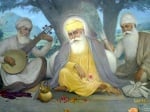Template:AOW3: Difference between revisions
Hari singh (talk | contribs) No edit summary |
Hari singh (talk | contribs) No edit summary |
||
| Line 1: | Line 1: | ||
{{Aowh|[[Shabad Kirtan|Gurmat Sangeet]]}} | {{Aowh|[[Shabad Kirtan|Gurmat Sangeet]]}} | ||
{{pm|Image:Guru Nanak-1024X768.jpg|<!----<small>[[Guru Nanak Dev]] with [[Bhai Mardana]] and [[Bhai Bala]] singing [[Shabad]] [[Kirtan]]</small>---->}} | |||
'''[[Shabad Kirtan|Gurmat Sangeet or Shabad Kirtan]]''' has been an integral part of [[Sikh]] worship from the very beginning. Hymn-singing was in fact the earliest form of devotion for the [[Sikh]]s. | |||
Even during the time of [[Guru Nanak]], the disciples assembled together to sing [[shabad]]s, i.e. hymns composed by the [[Guru]] which render praise to the Lord. Thus, [[Kirtan]] has been appropriated into the regular [[Gurdwara]] service for a long time. | |||
Although [[Kirtan]] can be very touching and soul-stirring, [[Sikh]] [[kirtan]] abstains from all outward expression or frenzy in the form of clapping and dancing. Praise is offered to the Supreme Being who is without form, [[nirankar]] and not to a deity in any embodiment or incarnation. | |||
The texts of [[shabad]] [[kirtan]] are from the [[Holy Book]] of [[Sikh]]s known as the [[Guru Granth Sahib]], or [[Adi Granth]], compiled by [[Guru Arjan]] in 1604 or from from the [[Dasam Granth]] and also sometimes from the compositions by [[Bhai Gurdas]] or [[Bhai Nand Lal]]. Probably no other religion shows a closer relationship between music and its scriptures than does [[Sikhism]]. The [[Holy Book]] is organized according to [[raga]]s, 31 in number, to which the poetic hymns belong. {{Aowf|Shabhad Kirtan}} | The texts of [[shabad]] [[kirtan]] are from the [[Holy Book]] of [[Sikh]]s known as the [[Guru Granth Sahib]], or [[Adi Granth]], compiled by [[Guru Arjan]] in 1604 or from from the [[Dasam Granth]] and also sometimes from the compositions by [[Bhai Gurdas]] or [[Bhai Nand Lal]]. Probably no other religion shows a closer relationship between music and its scriptures than does [[Sikhism]]. The [[Holy Book]] is organized according to [[raga]]s, 31 in number, to which the poetic hymns belong. {{Aowf|Shabhad Kirtan}} | ||
Latest revision as of 20:41, 29 January 2012
Gurmat Sangeet or Shabad Kirtan has been an integral part of Sikh worship from the very beginning. Hymn-singing was in fact the earliest form of devotion for the Sikhs.
Even during the time of Guru Nanak, the disciples assembled together to sing shabads, i.e. hymns composed by the Guru which render praise to the Lord. Thus, Kirtan has been appropriated into the regular Gurdwara service for a long time.
Although Kirtan can be very touching and soul-stirring, Sikh kirtan abstains from all outward expression or frenzy in the form of clapping and dancing. Praise is offered to the Supreme Being who is without form, nirankar and not to a deity in any embodiment or incarnation.
The texts of shabad kirtan are from the Holy Book of Sikhs known as the Guru Granth Sahib, or Adi Granth, compiled by Guru Arjan in 1604 or from from the Dasam Granth and also sometimes from the compositions by Bhai Gurdas or Bhai Nand Lal. Probably no other religion shows a closer relationship between music and its scriptures than does Sikhism. The Holy Book is organized according to ragas, 31 in number, to which the poetic hymns belong. .....More

